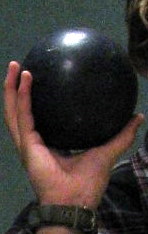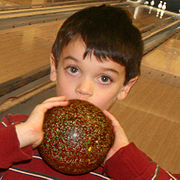
Duckpin bowling
Encyclopedia

Bowling
Bowling Bowling Bowling (1375–1425; late Middle English bowle, variant of boule Bowling (1375–1425; late Middle English bowle, variant of boule...
. The balls used in duckpin bowling are 4-3/4 in (12 cm) to 5 in (12.7 cm) in diameter (which is slightly larger than a softball), weigh 3 lb 6 oz (1.5 kg) to 3 lb 12 oz (1.7 kg) each, and lack finger holes. They are thus significantly smaller than those used in ten-pin bowling
Ten-pin bowling
Ten-pin bowling is a competitive sport in which a player rolls a bowling ball down a wooden or synthetic lane with the objective of scoring points by knocking down as many pins as possible.-Summary:The lane is bordered along its length by semicylindrical channels Ten-pin bowling (commonly just...
but are slightly larger and heavier than those used in candlepin bowling
Candlepin bowling
Candlepin bowling is a variation of Bowling that is played primarily in the Canadian Maritime provinces, Ontario, Quebec, and the New England states of Maine, Massachusetts and New Hampshire, where it is more common than ten-pin bowling....
. The pins, while arranged in a triangular fashion identical to that used in ten-pin bowling, are shorter, smaller, and lighter than their ten-pin equivalents which makes it more difficult to achieve a strike
Strike (bowling)
A strike is a term used in bowling to indicate that all of the pins have been knocked down with the first ball of a frame. On scoresheets, a strike is symbolized by an X.-Scoring:...
. For this reason (and similar to candlepin bowling), the bowler is allowed three rolls per frame (as opposed to the standard two rolls per frame in ten-pin bowling).
Duckpin bowling centers are located in Connecticut
Connecticut
Connecticut is a state in the New England region of the northeastern United States. It is bordered by Rhode Island to the east, Massachusetts to the north, and the state of New York to the west and the south .Connecticut is named for the Connecticut River, the major U.S. river that approximately...
, Massachusetts
Massachusetts
The Commonwealth of Massachusetts is a state in the New England region of the northeastern United States of America. It is bordered by Rhode Island and Connecticut to the south, New York to the west, and Vermont and New Hampshire to the north; at its east lies the Atlantic Ocean. As of the 2010...
, Rhode Island
Rhode Island
The state of Rhode Island and Providence Plantations, more commonly referred to as Rhode Island , is a state in the New England region of the United States. It is the smallest U.S. state by area...
, Indiana
Indiana
Indiana is a US state, admitted to the United States as the 19th on December 11, 1816. It is located in the Midwestern United States and Great Lakes Region. With 6,483,802 residents, the state is ranked 15th in population and 16th in population density. Indiana is ranked 38th in land area and is...
(near downtown Indianapolis
Indianapolis
Indianapolis is the capital of the U.S. state of Indiana, and the county seat of Marion County, Indiana. As of the 2010 United States Census, the city's population is 839,489. It is by far Indiana's largest city and, as of the 2010 U.S...
), Maryland
Maryland
Maryland is a U.S. state located in the Mid Atlantic region of the United States, bordering Virginia, West Virginia, and the District of Columbia to its south and west; Pennsylvania to its north; and Delaware to its east...
(especially in the Baltimore
Baltimore
Baltimore is the largest independent city in the United States and the largest city and cultural center of the US state of Maryland. The city is located in central Maryland along the tidal portion of the Patapsco River, an arm of the Chesapeake Bay. Baltimore is sometimes referred to as Baltimore...
area) and in suburban Washington, DC.
Rules
Duckpin bowling has rules similar to ten-pin bowling. In a 10-frame game, bowlers try to knock down pins in the fewest rolls per frame. Bowlers have three balls per frame, instead of two in ten-pin bowling, to knock over a set of 10 pins. If a bowler knocks down all 10 pins with their first roll in a frame, it is scored as a strikeStrike (bowling)
A strike is a term used in bowling to indicate that all of the pins have been knocked down with the first ball of a frame. On scoresheets, a strike is symbolized by an X.-Scoring:...
. If all the pins are knocked down in two rolls, the bowler has made a spare
Spare (bowling)
A spare is a term used in bowling to indicate that all of the pins have been knocked down after the second ball of a frame. The symbol for a spare is a slash mark ....
. If all the pins are knocked down in three rolls, the bowler gets 10 points, as in candlepins, with no bonus. If pins are still standing after the third ball, the bowler gets one point for each pin knocked down.


History
The origin of the sport is a subject of some debate. One possible origin is that duckpin bowling began in Baltimore around 1900, at a bowling center owned by future baseball Hall of Famers John McGraw and Wilbert RobinsonWilbert Robinson
Wilbert Robinson , nicknamed "Uncle Robbie", was an American catcher, coach and manager in Major League Baseball...
, both of the then Baltimore Orioles
Baltimore Orioles (19th century)
The Baltimore Orioles were a 19th-century American Association and National League team from 1882 to 1899. The club, which featured numerous future Hall of Famers, finished in first place three consecutive years and won the Temple Cup championship in 1896 and 1897...
.
However, according to a 2005 baseball book by Howard W. Rosenberg (Cap Anson 3: Muggsy John McGraw and the Tricksters: Baseball's Fun Age of Rule Bending), an article from May 1894 in the Lowell Sun confirms the existence of duckpins. Rosenberg traced the story of crediting the origins of duckpins to McGraw and Robinson as far back as Shirley Povich
Shirley Povich
Shirley Lewis Povich was an American sports columnist and reporter for the Washington Post.-Biography:Povich's parents were Jewish immigrants from Lithuania...
of the Washington Post in the late 1930s.
In 1985, a 130-plus-page publication called Duckpins: The Tenth Frame cited related Lowell, Mass., coverage of duckpin bowling in May 1894. Writing in that publication, Bob Tkacz, of Newington, Connecticut
Newington, Connecticut
Newington is a town in Hartford County, Connecticut, United States. As of the 2000 census, it had a total population of 29,306. The Connecticut Department of Transportation has its headquarters in Newington....
, noted finding articles showing that a duckpin tournament was being held in Lowell at that time. The 1985 publication is not readily available from any U.S. library, which explains why Tkacz's finding was easy to miss as the earliest known "in print" rebuttal of the Baltimore origin myth. Articles can be found in the Globe earlier than May 1894 showing the existence of the sport around Boston. According to Rosenberg, the earliest Globe reference to duckpins was on January 2, 1893.
Rosenberg's book methodically accounted for Baltimore newspaper reporting in late 1899 and early 1900, when the sport seemingly was invented in Baltimore (at the McGraw-Robinson center.) Baltimore Sun next-day reporting seems to credit the center for introducing the sport to Baltimore the night before.
In 1982, the Women's National Duckpin Association was formed to give women a venue to compete in duckpins at a professional level. The organization conducts several tournaments yearly in New England and the Mid-Atlantic. The final tournament each year is called the Grand Prix.
Variants
In the 1930s a variant called rubber band duckpins was introduced in the Baltimore-Washington area. The pins are circled with hard rubber bands to increase action and scoring. Rubber band duckpin is the only version of duckpin played in the province of QuebecQuebec
Quebec or is a province in east-central Canada. It is the only Canadian province with a predominantly French-speaking population and the only one whose sole official language is French at the provincial level....
. Bowlers tend to throw slowly with their fingers facing forward to give the ball backspin. There have been perfect games bowled in rubber band duckpin, including the largest duckpin prize ever won on television, C$
Canadian dollar
The Canadian dollar is the currency of Canada. As of 2007, the Canadian dollar is the 7th most traded currency in the world. It is abbreviated with the dollar sign $, or C$ to distinguish it from other dollar-denominated currencies...
50,000 in 1994. Since it is easier to knock down pins in rubber band duckpin, its rules are identical to those of standard ten-pin bowling.
Many duckpin centers are around the world today. They recently put duckpin bowling in Florida
Florida
Florida is a state in the southeastern United States, located on the nation's Atlantic and Gulf coasts. It is bordered to the west by the Gulf of Mexico, to the north by Alabama and Georgia and to the east by the Atlantic Ocean. With a population of 18,801,310 as measured by the 2010 census, it...
and Kentucky
Kentucky
The Commonwealth of Kentucky is a state located in the East Central United States of America. As classified by the United States Census Bureau, Kentucky is a Southern state, more specifically in the East South Central region. Kentucky is one of four U.S. states constituted as a commonwealth...
. Duckpin bowling is still growing today.
External links
- Duckpins.com - Duckpin bowling information and history.
- National Duckpin Bowling Congress
- Women's National Duckpin Association
- Duckpin Professional Bowlers Association (new URL)
- A June 2008 feature story on duckpin bowling in the Urbanite, a Baltimore weekly magazine
- A duckpin bowling score calculator
- A Sherman duckpin pinspotter in action
- Frontside view of the Sherman pinspotter in action

